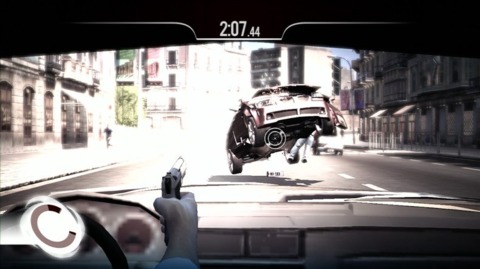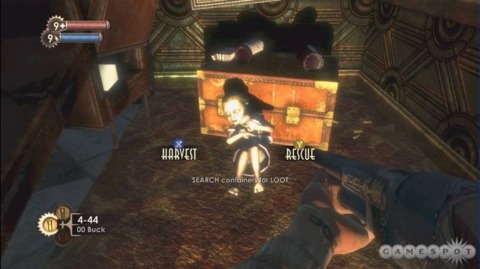GDC 2009: Kaos gives Big Huge tips on cinematic gaming
Rise of Nations, Frontline studio reps tell developers how to make their games more Hollywood-like without using cutscenes.
SAN FRANCISCO--While not as prominent as the annual Game Design Challenge, the Game Developers Conference also has a recurring session on Cinematic Game Design. This year's installment closed out the show on Friday afternoon with a lecture explaining how developers can borrow elements from action films to make their in-game action more impactful to players.
Presenting the session was a potentially awkward combination of one THQ developer, Kaos Studios lead single-player designer Richard Rouse III, and one soon-to-be-ex-THQ developer, Big Huge Games cinematic director Martin Stoltz. (The publisher revealed the last leg of its massive restructuring plan earlier this month, saying that Big Huge Games would be sold or shut down if a buyer can't be found.)
Rouse started the presentation emphasizing that he doesn't want to promote bad cinematic design or design that makes games less like an interactive medium. He then explained that games arguably already do action better than their film counterparts but stressed that there are still cinematic techniques that can be applied to action scenes in games.
One technique the pair wanted to emphasize was the pacing of an action scene and the way that changing the tempo adds to its impact. Stoltz pointed to a clip from the climax of The Wild Bunch with roller-coaster-like pacing. A rapid-fire gunfight suddenly goes quiet and turns into a tense standoff. When one of the protagonists pulls the trigger and starts the fight back up, an assault of quick cuts and gunshots leaves viewers with a sense of the overwhelming odds the main characters face.

Rouse contrasts that with a scene from Stranglehold where the main character dodges bullets in a slow motion standoff before the speed resumes to normal and the game becomes a fast-paced shootout once more. Stoltz said the tension and anticipation of the wild firefights in these clips do wonders to improve their final payoff and impact.
Call of Duty 4 was another game up for praise from Rouse. He mentioned a climactic scene in the game where the player is knocked out in order to begin a scripted event. He points to it as a well-justified reason to take some of the player's control away. At the same time, it lets players maintain some control, and the scene makes an effective compromise between guiding players through a dramatic series of events and maintaining the interactivity.
Next the pair talked about car chases. Stoltz pointed out that directors have toyed with camera position in cinematic car chases for years. Putting the camera outside the car to show the havoc created by a high-speed chase through city streets detaches the viewer from the drivers and makes them concern themselves more with the chaos being inflicted upon the city. On the other hand, using in-the-car shots of the effects collisions have on the driver, as in the Bourne films, makes viewers relate more with the person inside the car.

For an example of this technique in games, Rouse showed a clip from The Wheelman, where players drive through traffic from a behind-the-car view. However, Rouse notes that the developers wanted to get into the car, so they gave players a slow-motion 360 spin-out during which the camera zooms into the car and players get a chance to fire off shots at their pursuers.
Stotlz also wanted to point out the way toying with scale sets up a sense of height. He points to the classic Hitchcock film Saboteur, where a man tries to rescue another clinging from the side of the Statue of Liberty's torch. Much of the scene was shot close up enough that viewers couldn't see more than the top of the torch. But Hitchcock selectively cut back to longer shots looking down on the characters to remind the audience how high up they were and the danger involved in the situation.
Rouse singled out Mirror's Edge for its use of the technique. Players can hop along the city's skyscrapers without constantly being reminded how high up they are. However, players approaching an edge of a building can glance down and be quickly reminded--like those who miss a jump and plummet to their deaths. Assassin's Creed used the technique similarly. Players can scale the game's massive towers and be treated to a panoramic view of the surrounding area to show how high up they have climbed.
Familiar locations can also create a compelling new wrinkle in an action scene. Rouse pointed to Dead Rising's mall, Rainbow Six Vegas' casinos, and Duke Nukem 3D's movie theater level as examples of game settings where the action is made more interesting for players because of the environments. At the same time, a confusing environment can also pay off for the audience, much as it did during the mirror room shootout in Orson Welles' film The Lady From Shanghai or in the funhouse scene from Max Payne 2.

Stoltz wrapped up the session by talking about the action staple of the intimate death scene. He showed the final scene of David Cronenberg's The Dead Zone, where a character who can see the future by touching people receives a premonition that wraps up the film's main plotline. Rouse said many of the same techniques used to make that death scene intimate (varied pacing, slow-motion brutality, close-up camera angles) were used well with BioShock. Specifically, seeing the Little Sisters' emotions as players either saved them or harvested them greatly enhanced the impact of the decision for players, Rouse said. Even though those scenes weren't interactive, Rouse said it was excusable because the player had to initiate them in the first place.
All of the slides from Rouse's presentation--as well as those from previous years' Cinematic Game Design sessions--should be available soon at Rouse's Web site.
Got a news tip or want to contact us directly? Email news@gamespot.com
Join the conversation